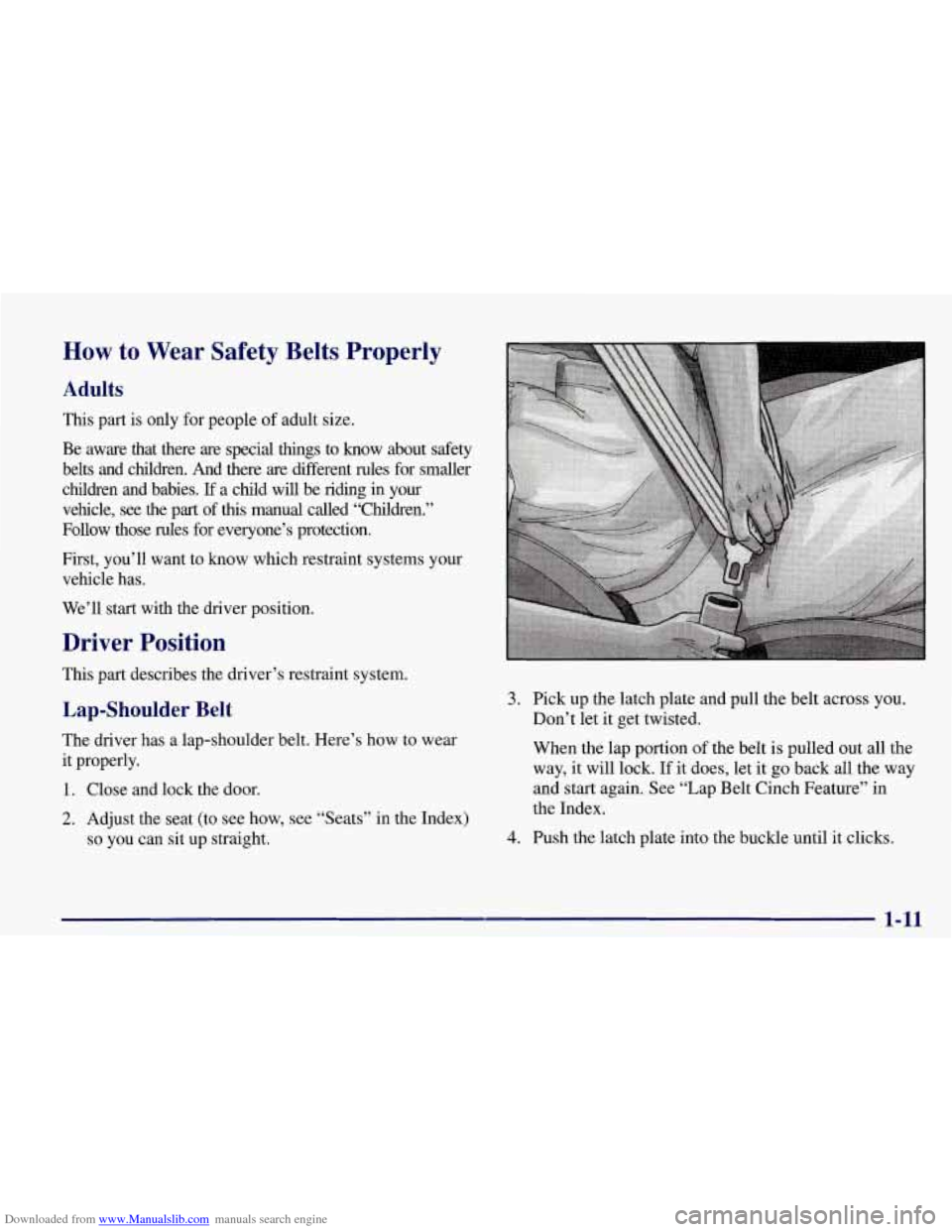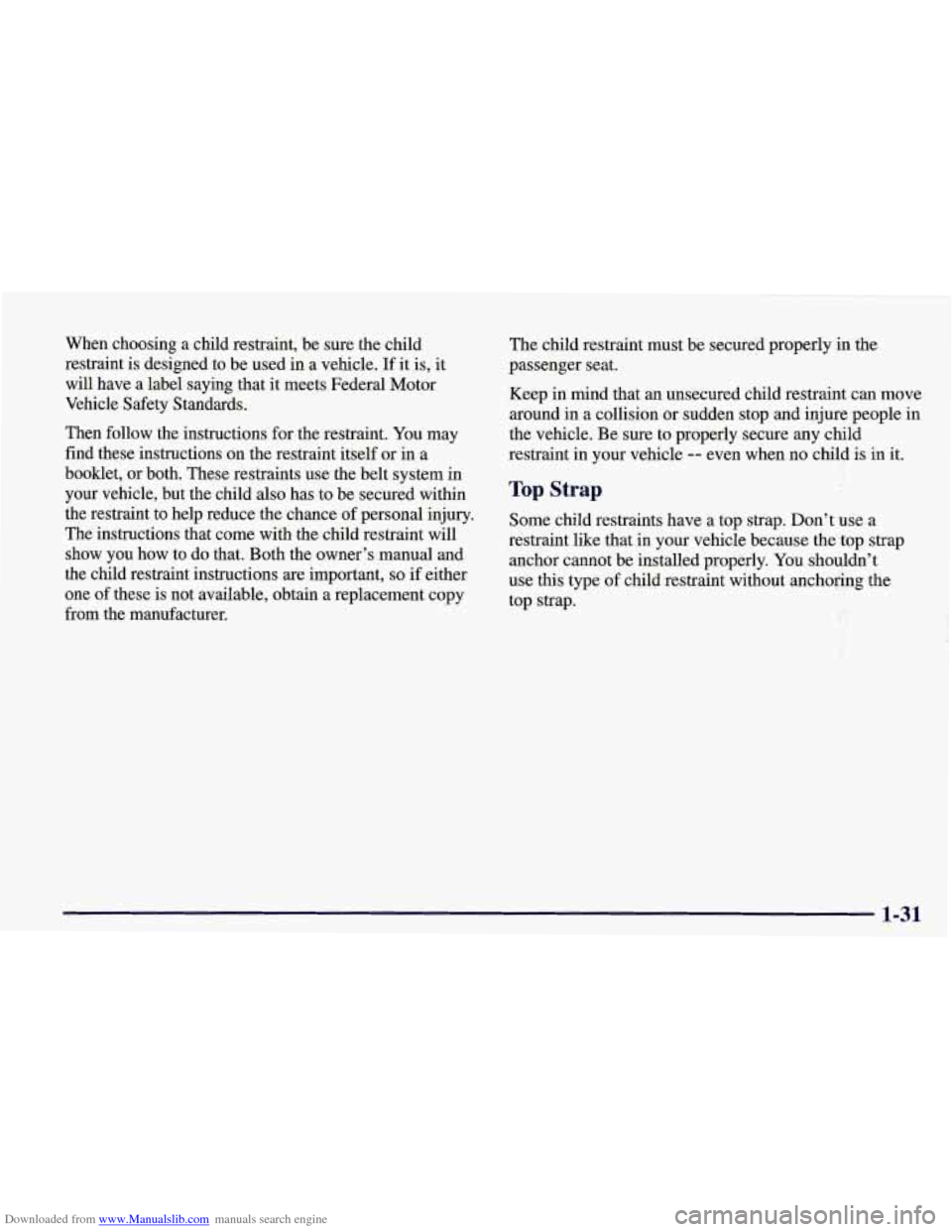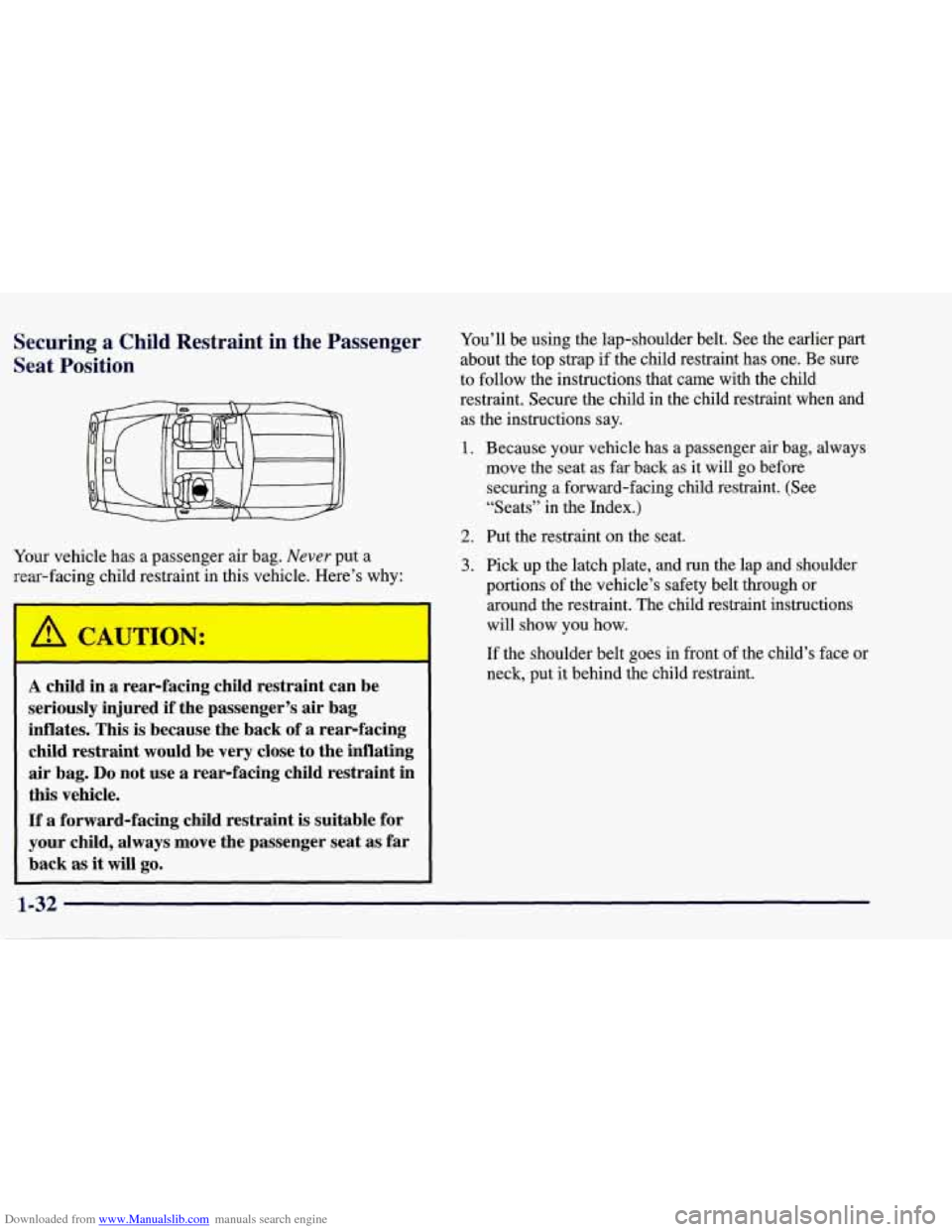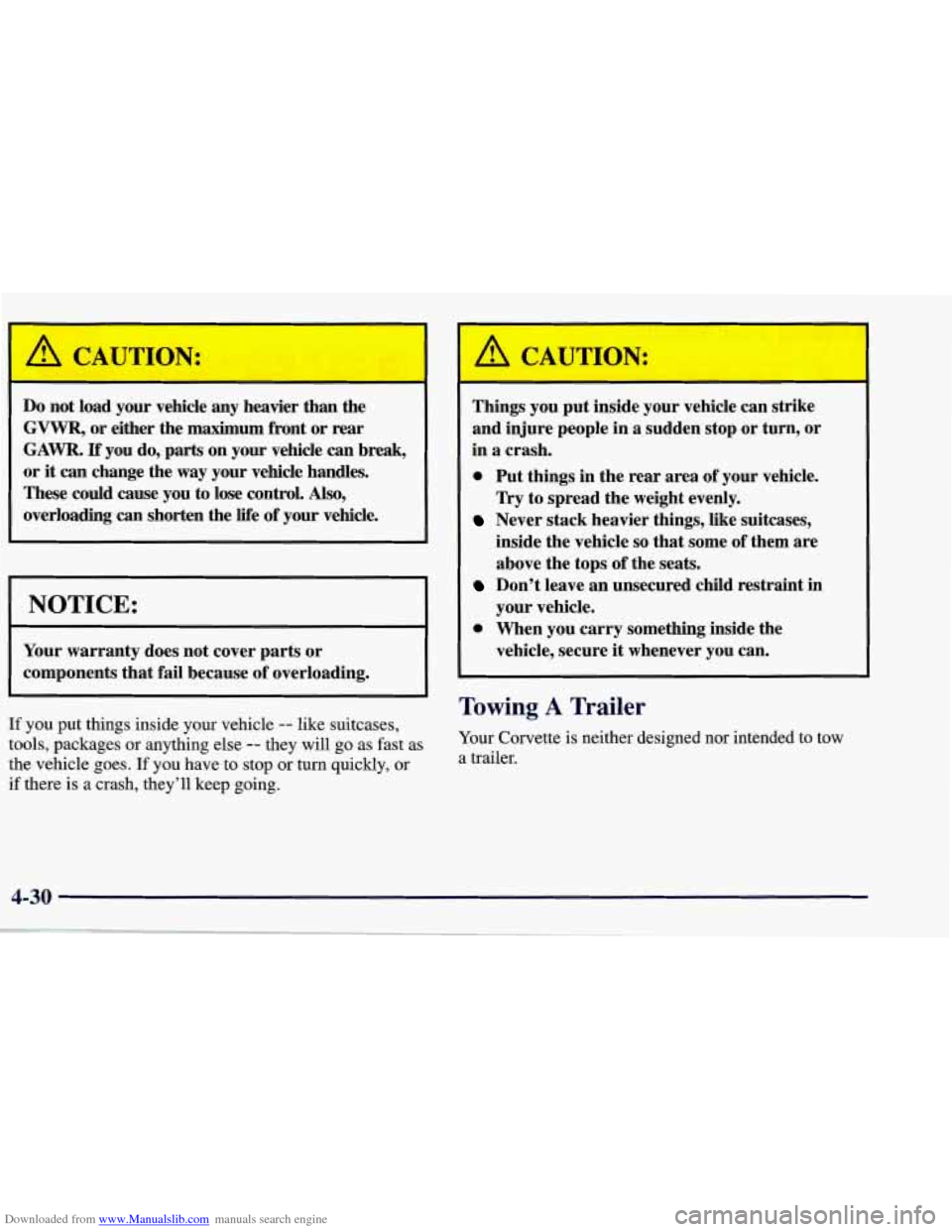Page 16 of 378
Downloaded from www.Manualslib.com manuals search engine Section 1 Seats and Restraint Systems
Here you’ll find information about the seats in your Corvette and how to use your safety belts properly. You can also
learn about some things you should not do with air bags and safety belts.
1-2 Seats and Seat Controls
1- 18 Air Bag System
1-5 Safety Belts: They’re for Everyone
1-25 Children
1
- 10 Here Are Questions Many People Ask About
Safety Belts
-- and the Answers 1-27 Child Restraints
After a Crash
1
- 18 Passenger Position 1-38
Replacing Restraint System Parts
1-17 Safety Belt Use During Pregnancy 1-37
Safety Belt Extender
1 - 11 How to Wear Safety Belts Properly 1-34 Larger
Children
1-11 Driver Position 1-37 Checking
Your Restraint Systems
1-1
Page 26 of 378

Downloaded from www.Manualslib.com manuals search engine How to Wear Safety Belts Properly
Adults
This part is only for people of adult size.
Be aware that there are special things to know about safety
belts and children.
And there are different rules for smaller
children and babies.
If a child will be ridmg in your
vehicle, see the
part of this manual called “Children.”
Follow those rules for everyone’s protection.
First, you’ll want to know which restraint systems your
vehicle has.
We’ll start with the driver position.
Driver Position
This part describes the driver’s restraint system.
Lap-Shoulder Belt
The driver has a lap-shoulder belt. Here’s how to wear
it properly.
1. Close and lock the door.
2. Adjust the seat (to see how, see “Seats” in the Index)
so you can sit up straight.
3. Pick up the latch plate and pull the belt across you.
Don’t let it get twisted.
When the lap portion of the belt is pulled out all the
way, it will lock. If it does, let it go back all the way
and start again. See “Lap Belt Cinch Feature” in
the Index.
4. Push the latch plate into the buckle until it clicks.
1-11
Page 44 of 378
Downloaded from www.Manualslib.com manuals search engine A forward-facing child restraint (C-E) positions a
child upright
to face forward in the vehicle. These
forward-facing restraints are designed to help protect
children
who are from 20 to 40 lbs. (9 to 18 kg) and
about 26 to
40 inches (66 to 102 cm) in height, or up
to around four years of age. One type, a convertible
restraint,
is designed to be used either as a rear-facing
infant seat
or a forward-facing child seat.
1-29
Page 45 of 378
Downloaded from www.Manualslib.com manuals search engine A booster seat (F, G) is designed for children who
are about 40 to 60 lbs. (1 8 to 27 kg) and about
four to eight years
of age. It’s designed to improve
the fit
of the vehicle’s safety belt system. Booster
seats with shields use lap-only belts; however,
booster seats without shields use lap-shoulder
belts. Booster seats can also help a child to see
out the window.
1-30
Page 46 of 378

Downloaded from www.Manualslib.com manuals search engine When choosing a child restraint, be sure the child
restraint is designed to be used in a vehicle.
If it is, it
will have a label saying that it meets Federal Motor
Vehicle Safety Standards.
Then follow the instructions for the restraint. You may
find these instructions on the restraint itself or in a
booklet, or both. These restraints use the belt system in
your vehicle, but the child also has to be secured within
the restraint to help reduce the chance of personal injury.
The instructions that come with the child restraint will
show you how to do that. Both the owner’s manual and
the child restraint instructions are important,
so if either
one
of these is not available, obtain a replacement copy
from the manufacturer. The child restraint must be
secured properly in the
passenger seat.
Keep in mind that
an unsecured child restraint can move
around in a collision or sudden stop and injure people in
the vehicle. Be sure to properly secure any child
restraint in your vehicle
-- even when no child is in it.
Top Strap
Some child restraints have a top strap. Don’t use a
restraint like that in your vehicle because the top strap
anchor cannot be installed properly. You shouldn’t
use this type of child restraint without anchoring the
top strap.
1-31
Page 47 of 378

Downloaded from www.Manualslib.com manuals search engine Securing a Child Restraint in the Passenger
Seat Position
Your vehicle has a passenger air bag. Never put a
rear-facing child restraint in this vehicle. Here’s why:
A child in a rear-facing child restraint can be
seriously injured if the passenger’s air bag
inflates. This is because the back of a rear-facing
child restraint would be very close to the inflating
air bag.
Do not use a rear-facing child restraint in
this vehicle.
If’ a forward-facing child restraint is suitable for
your child, always move the passenger seat as far
back
as it will go.
You’ll be using the lap-shoulder belt. See the earlier part
about the top strap if the child restraint has one. Be sure
to follow the instructions that came with the child
restraint. Secure the child in the child restraint when and
as the instructions say.
1. Because your vehicle has a passenger air bag, always
move the seat as far back as it will go before
securing a forward-facing child restraint. (See
“Seats” in the Index.)
2. Put the restraint on the seat.
3. Pick up the latch plate, and run the lap and shoulder
portions of the vehicle’s safety belt through
or
around the restraint. The child restraint instructions
will show you how.
If the shoulder belt goes in front of the child’s face or
neck, put it behind the child restraint.
Page 51 of 378
Downloaded from www.Manualslib.com manuals search engine /A CAUTION:
I
Never do this.
Here
a child is sitting in a seat that has a
lap-shoulder belt, but the shoulder part is behind
the child.
If the child wears the belt in this way, il
a crash the child might slide under the belt. The
belt’s force would then be applied right on the
child’s abdomen. That could cause serious or
fatal injuries.
The lap portion of the belt should be worn low and snug
on the hips, just touching the child’s thighs. This applies
belt force to the child’s pelvic bones in a crash.
Page 221 of 378

Downloaded from www.Manualslib.com manuals search engine Do not load your vehicle any heavier than the
GVWR, or either the maximum front or rear
GAWR. If you do, parts on your vehicle can break,
or it can change the way your vehicle handles.
These could cause you to lose control.
Also,
overloading can shorten the life of your vehicle.
NOTICE:
Your warranty does not cover parts or
components that fail because of overloading.
If you put things inside your vehicle -- like suitcases,
tools, packages
or anything else -- they will go as fast as
the vehicle goes.
If you have to stop or turn quickly, or
if there is a crash, they’ll keep going.
rn I
A CAUTION:
Things you put inside your vehicle can strike
and injure people in a sudden stop or turn, or
in
a crash.
0 Put things in the rear area of your vehicle.
Never stack heavier things, like suitcases,
lky to spread the weight evenly.
inside the vehicle
so that some of them are
above the tops of the seats.
Don’t leave an unsecured child restraint in
your vehicle.
0 When you carry something inside the
vehicle, secure
it whenever you can.
Towing A Trailer
Your Corvette is neither designed nor intended to tow
a trailer.